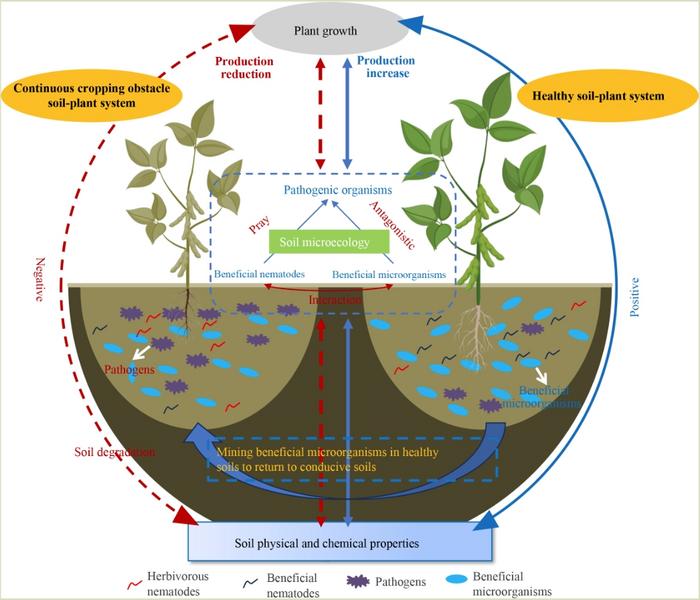Continuous cropping obstacles (CCOs) refer to the phenomenon that the same crop or its related species are continuously planted on the same plot, and even under normal management conditions, the yield and quality of products are still reduced, and the diseases and insect pests become serious. CCOs can cause crop yield losses of up to 20%–80%. Areas with severe continuous cropping problems will almost suffer a total loss of production, which has become one of the biggest limiting factors for agricultural capacity expansion and sustainability. In the past, the question of CCOs has always perplexed agricultural scientists: What is the cause of CCOs? Will long-term continuous cropping definitely lead to CCOs? How to reduce CCOs?

Credit: Kunguang WANG, Qiaofang LU, Zhechao DOU, Zhiguang CHI, Dongming CUI, Jing MA, Guowei WANG, Jialing KUANG, Nanqi WANG, Yuanmei ZUO
Continuous cropping obstacles (CCOs) refer to the phenomenon that the same crop or its related species are continuously planted on the same plot, and even under normal management conditions, the yield and quality of products are still reduced, and the diseases and insect pests become serious. CCOs can cause crop yield losses of up to 20%–80%. Areas with severe continuous cropping problems will almost suffer a total loss of production, which has become one of the biggest limiting factors for agricultural capacity expansion and sustainability. In the past, the question of CCOs has always perplexed agricultural scientists: What is the cause of CCOs? Will long-term continuous cropping definitely lead to CCOs? How to reduce CCOs?
To answer these questions, this article summarizes past studies. CCOs is the external manifestation of the interaction between plants, soil, microorganisms, and the environment. Soil degradation, soil ecological environment deterioration, and plant autotoxicity are the main causes of CCOs. However, not all soils will have CCOs after long-term continuous cropping. In continuous cropping, there are three main disease patterns of soil-borne diseases: (1) continuous severe type, is manifested in that the disease becomes more serious and the crop yield continues to decrease during the entire continuous cropping process; ( 2) late relief type, is manifested in that the soil-borne diseases are serious in the early stage of continuous cropping, and the disease-suppressing soil is formed in the late stage of continuous cropping, and the soil-borne diseases are alleviated; (3) continuous fluctuation type, is manifested in the alternation of severe disease period and disease relief period during continuous cropping. The rhizobiont theory emphasizes that nutrient efficiency is a process of synergistic interaction and improvement of multi-interface systems from soil to soil organisms to plants. Therefore, to solve the problem of CCOs, it is necessary to reduce from the system level by regulating the cascade amplification effect of the various interfaces of the rhizosphere. Through reasonable water and fertilizer management, optimized planting structure, conservation tillage, soil biological regulation, and other measures, the soil micro-food web structure can be regulated to achieve the reduction of CCOs. This paper summarizes the pathogenesis of soil-borne diseases in continuous cropping soils, and proposes that it is necessary to start from the system perspective of plant–soil–soil biological interactions and prevent soil-borne diseases in a targeted manner to achieve the reduction of continuous cropping obstacles. This study has been published on the Journal of Frontiers of Agricultural Science and Engineering in Vol. 11, No. 2, 2024, DOI: 10.15302/J-FASE-2024543.
Journal
Frontiers of Agricultural Science and Engineering
Method of Research
Experimental study
Subject of Research
Not applicable
Article Title
A review of research progress on continuous cropping obstacles
Article Publication Date
28-Feb-2024



